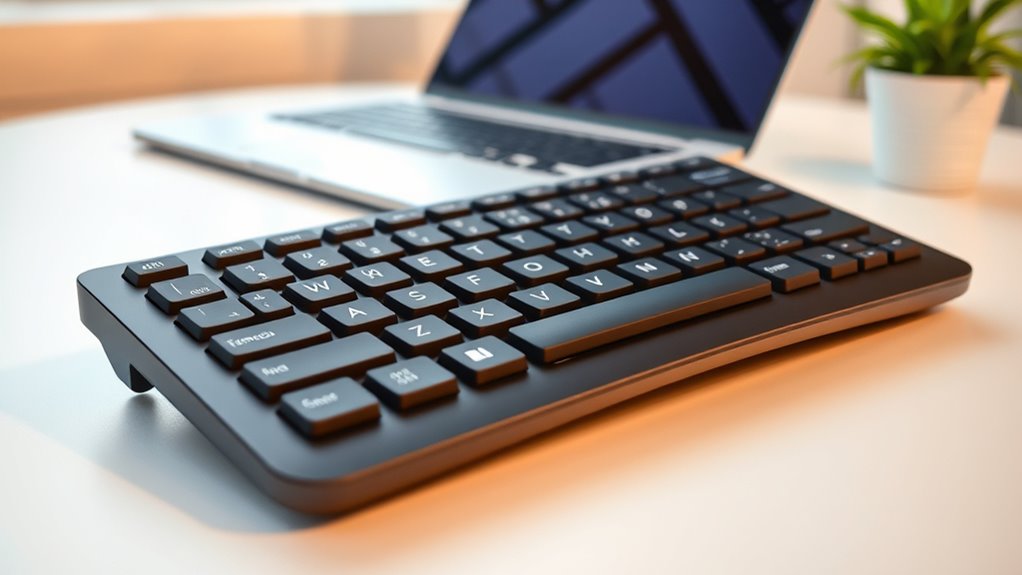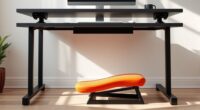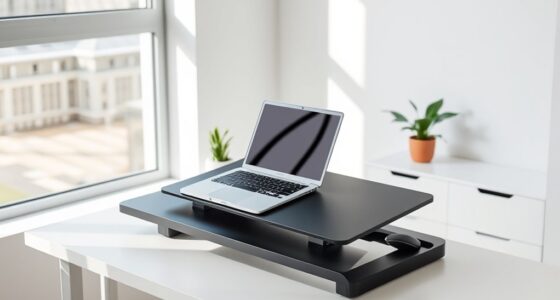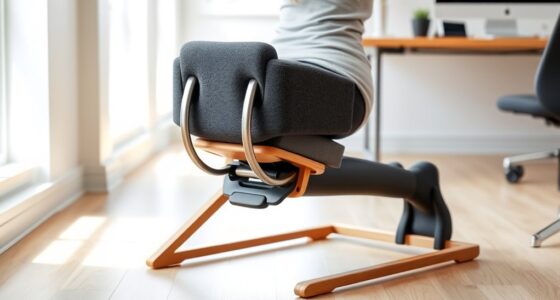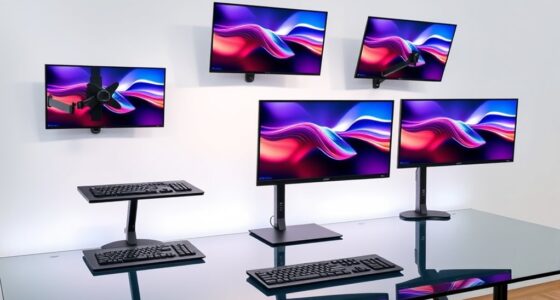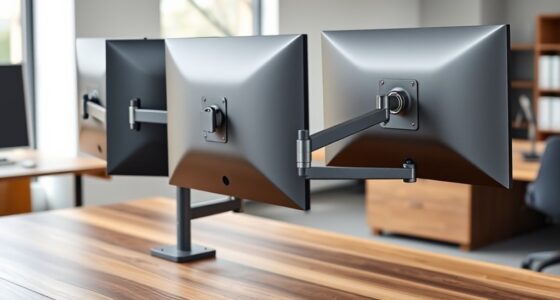If you have small hands, I recommend ergonomic keyboards that offer compact layouts, adjustable tilt, and supportive features like cushioned wrist rests. Devices like the R-Go Split, Logitech Wave, or Kensington Pro Fit balance comfort and efficiency with natural key positioning and customizable setups. Wireless options provide freedom of movement, while wired models ensure reliability. To find the perfect fit for your needs, explore these top choices closer—there’s plenty more to discover.
Key Takeaways
- Look for compact, narrow layouts with minimized finger travel to suit small hands comfortably.
- Prioritize keyboards with adjustable tilt, tenting, and ergonomic curves for personalized wrist support.
- Choose models with split or wave-shaped designs that promote natural hand and shoulder positioning.
- Ensure compatibility with your device via wired, Bluetooth, or 2.4GHz wireless options for flexible use.
- Opt for durable materials, cushioned wrist rests, and responsive keys to enhance comfort and long-term efficiency.
R-Go Split Ergonomic Keyboard with Break Software, USB-C Wired, Compatible with Windows/MacOS

If you have small hands and struggle with standard keyboards, the R-Go Split Ergonomic Keyboard might be your ideal choice. Its split design encourages natural shoulder, elbow, and wrist positions, reducing strain. It’s compact, lightweight, and easily portable, fitting into laptop bags for on-the-go use. The flexible cable lengths let you customize your setup, while the slim profile and brushed metal casing give it a modern look. The keyboard features low-profile butterfly switches for comfortable typing. With programmable Break Software and LED indicators, it promotes healthy habits. Compatible with Windows and MacOS via USB-C wired connection, it’s perfect for those seeking ergonomic relief without sacrificing portability.
Best For: individuals with small hands or those seeking an ergonomic, portable keyboard to reduce strain during typing.
Pros:
- Compact and lightweight design easily fits into laptop bags for portability
- Split ergonomic layout promotes natural shoulder, elbow, and wrist positioning
- Programmable Break Software with LED indicators encourages healthy typing habits
Cons:
- Unconventional key placement such as vertical Enter and shared Num Lock may require adaptation
- Connectivity issues with certain USB hubs or switches can limit multi-PC use
- Lacks wireless (Bluetooth) options and a numeric keypad, which may restrict some workflows
ProtoArc Wireless Ergonomic Keyboard (EK04)
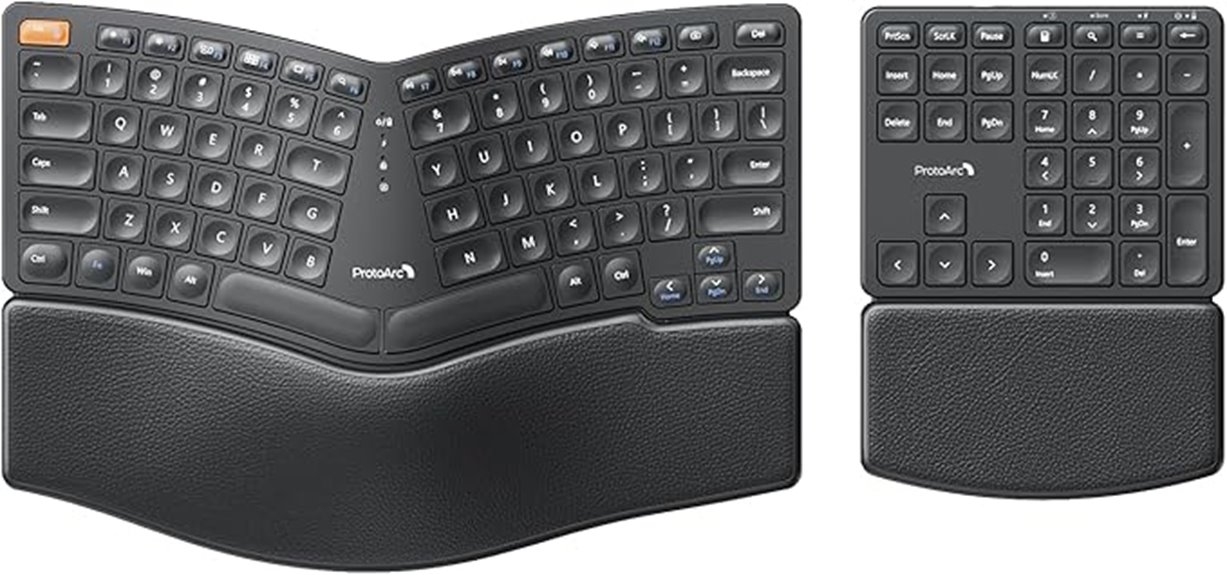
The ProtoArc Wireless Ergonomic Keyboard (EK04) stands out as an excellent choice for users with small hands seeking a compact yet comfortable typing experience. Its curved, split keyset promotes natural wrist and forearm posture, reducing strain. Scooped, fingertip-matched keys provide good response and comfort for extended use. The hard leather wrist rest offers durable support, while adjustable tilt legs help customize typing angles. Operating via a 2.4GHz USB receiver, it’s compatible only with Windows, with quick, seamless setup. The low-profile keys are quiet yet responsive. Overall, the EK04 balances ergonomic design, portability, and functionality, making it a smart option for small-handed users prioritizing comfort and efficiency.
Best For: users with small hands seeking a compact, ergonomic keyboard that reduces wrist strain and enhances comfort during long typing sessions.
Pros:
- Ergonomic, split, and curved design promotes natural wrist and forearm posture.
- Quiet, scooped keys with good feedback suitable for quiet environments.
- Detachable numeric keypad and leather wrist rest enhance workspace flexibility and comfort.
Cons:
- Compatible only with Windows systems; no support for Mac or Bluetooth connectivity.
- Some users report occasional key registration issues like double presses or missed keys.
- Slightly compact size may limit the inclusion of extra function keys or advanced shortcuts.
Logitech Wave Keys Wireless Ergonomic Keyboard with Cushioned Palm Rest
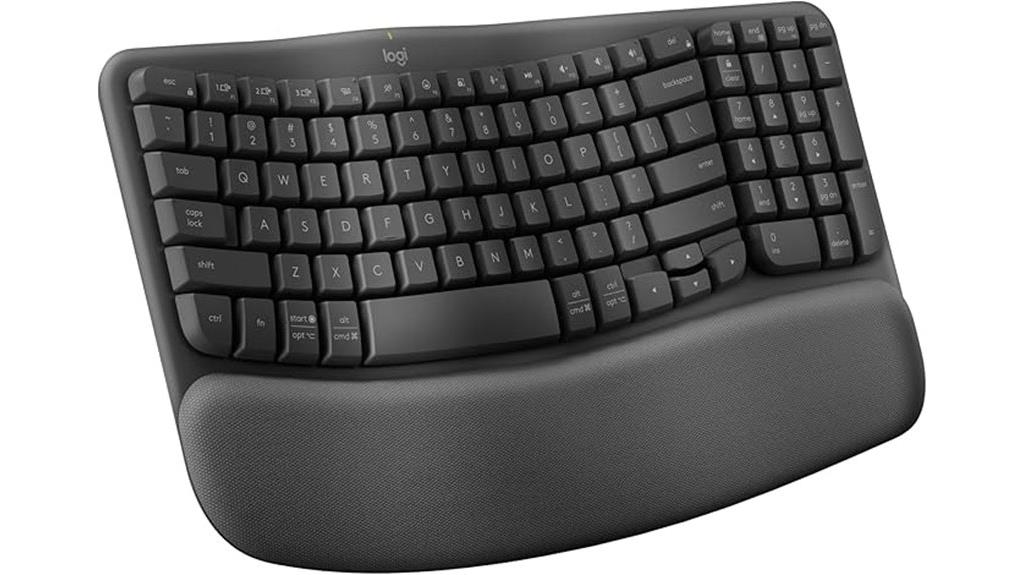
For those with small hands seeking an ergonomic keyboard, the Logitech Wave Keys Wireless Ergonomic Keyboard stands out with its wave-shaped design that naturally aligns your hands, wrists, and forearms. Its compact keys bring your mouse closer, promoting better shoulder posture, while the cushioned palm rest with memory foam offers all-day wrist support. Designed and tested by ergonomists, it’s proven to reduce wrist strain and improve comfort. Users report significant relief from wrist pain, appreciating the quiet, responsive keys. With multi-device connectivity, customizable shortcuts, and a long battery life, this keyboard balances ergonomic benefits with practical features, making it a top choice for sustained, comfortable typing.
Best For: individuals with small hands seeking an ergonomic, comfortable keyboard for long hours of typing and reduced wrist strain.
Pros:
- Ergonomic, wave-shaped design promotes natural hand, wrist, and forearm alignment.
- Cushioned palm rest with memory foam enhances all-day wrist support and comfort.
- Long battery life of up to 3 years and seamless multi-device connectivity for versatile use.
Cons:
- Prioritized function keys may require using the Fn key for traditional F1-F12 functions.
- Slightly compact keys might take time to get accustomed to for some users.
- Some users report minor issues with function key layout and customization options.
Nulea Wireless Ergonomic Keyboard with Wrist Rest
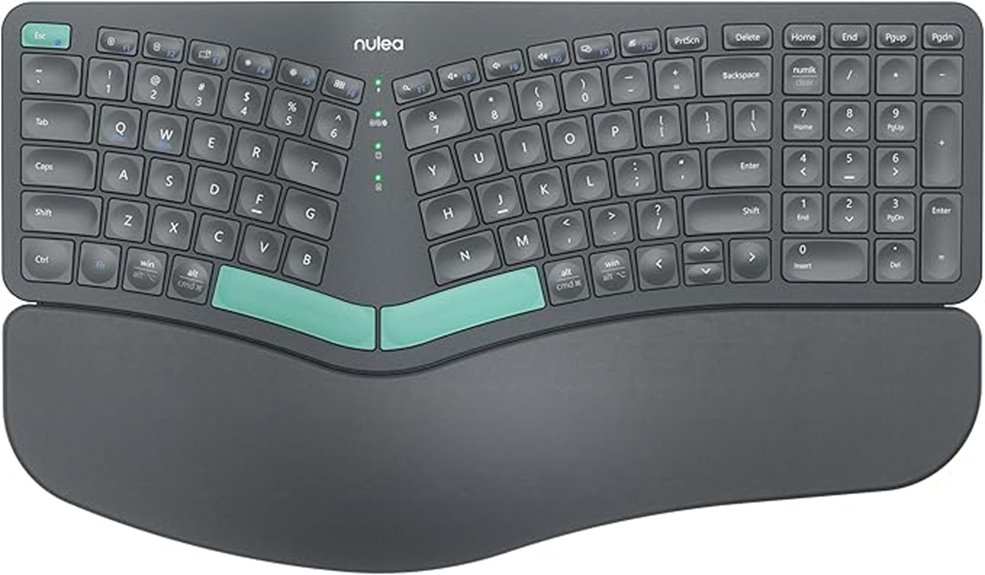
Designed with small hands in mind, the Nulea Wireless Ergonomic Keyboard with Wrist Rest offers a split design that promotes natural hand alignment, reducing strain during long typing sessions. Its oversized, soft leatherette wrist rest provides all-day support, while adjustable tilt options let you customize your typing angle. The smooth keys with finger-indenting features enhance comfort and minimize wrist pain, making it ideal for those with conditions like radial tunnel syndrome. With seamless Bluetooth and USB connectivity, long-lasting battery life, and a sleek modern look, this keyboard combines ergonomic benefits with versatile compatibility, making it a top choice for comfortable, efficient typing.
Best For: users with small hands seeking an ergonomic keyboard that reduces wrist strain and offers customizable comfort for long typing sessions.
Pros:
- Promotes natural hand alignment with split ergonomic design and adjustable tilt
- Comfortable, oversized leatherette wrist rest that supports all-day use
- Wireless connectivity via Bluetooth and USB dongle ensures versatile device compatibility
Cons:
- Some users may experience connectivity issues over time
- Battery life, while impressive, can be affected by frequent use or connectivity problems
- The compact size might limit key travel or typing experience for some users accustomed to larger keyboards
EDJO Wireless Ergonomic Keyboard with Wrist Rest
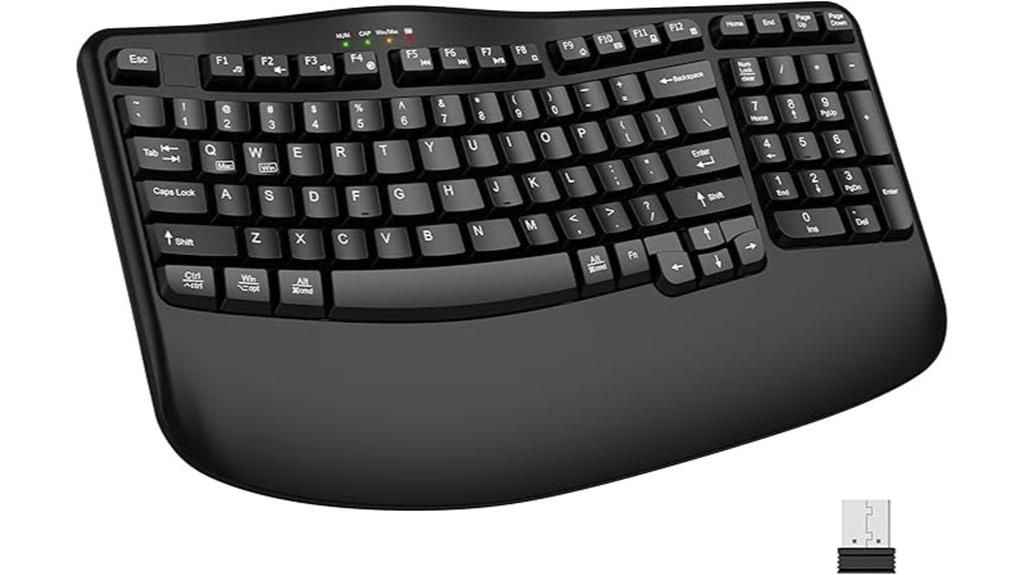
If you’re looking for an ergonomic keyboard that offers comfort and support for medium-large hands, the EDJO Wireless Ergonomic Keyboard with Wrist Rest stands out. Its wave-shaped keys and ergonomic layout promote natural hand and arm alignment, reducing fatigue. The wide palm rest keeps wrists properly supported, while the compact size encourages better shoulder and arm posture. It features a full-size layout with a numeric keypad and 12 multimedia shortcuts, though some keys like Insert and Delete are missing. With reliable 2.4GHz wireless connectivity, compatibility across multiple systems, and a built-in auto sleep mode, it delivers a practical, comfortable typing experience.
Best For: users with medium-large hands seeking an ergonomic, comfortable wireless keyboard with a supportive wrist rest and natural key layout.
Pros:
- Wave-shaped keys and ergonomic design reduce hand and arm fatigue during long typing sessions
- Reliable 2.4GHz wireless connection with a long 33-foot range ensures stable performance
- Wide palm rest and compact size promote proper wrist, shoulder, and arm posture, enhancing comfort
Cons:
- Some users may need time to adjust to the wave-shaped key layout
- Missing keys like Insert and Delete could impact productivity for certain tasks
- Material feels somewhat cheap, which may affect perceived build quality
Kensington Pro Fit Ergonomic Wireless Keyboard and Mouse – Black (K75406US)

The Kensington Pro Fit Ergonomic Wireless Keyboard and Mouse set is a strong choice for small-handed users seeking a comfortable, space-saving keyboard. Its split, sloped layout with adjustable tilt promotes natural wrist and forearm positioning, while the built-in wrist rest offers extra support. The compact design is ideal for limited desk space, but may take time to get used to due to close key placement and a slightly curved shape. The keyboard’s silent, spill-proof keys and responsive mouse with five buttons enhance usability. While some users experience connectivity issues or a learning curve, many appreciate its ergonomic features and wireless convenience for home or office use.
Best For: small-handed users seeking a comfortable, space-saving ergonomic wireless keyboard and mouse solution for home or office use.
Pros:
- Ergonomic split and sloped design with adjustable tilt enhances natural wrist and forearm positioning.
- Quiet, spill-proof keys and a responsive five-button mouse improve typing and navigation comfort.
- Wireless connectivity options with secure encryption and replaceable receiver offer flexibility and ease of maintenance.
Cons:
- Some users report a learning curve due to the compact layout and close key placement.
- Connectivity issues such as drops, delays, or lag, especially with the 2.4 GHz dongle.
- Potential build quality concerns, including keys getting stuck or unintended double spacing.
Perixx PERIBOARD-512B Wired Ergonomic Keyboard
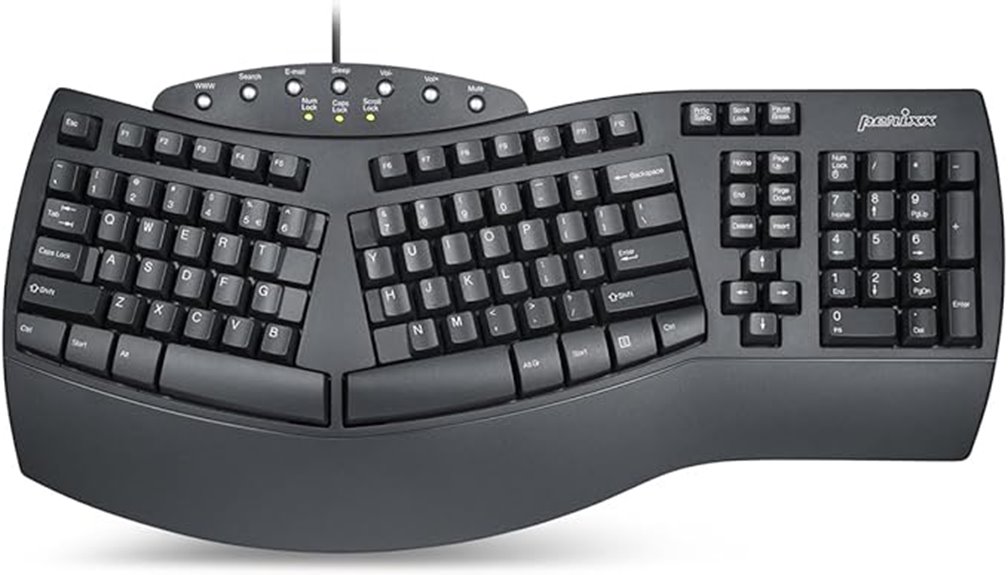
The Perixx PERIBOARD-512B Wired Ergonomic Keyboard is an excellent choice for small-handed users seeking comfort without sacrificing functionality. Its split, 3-D design aligns naturally with your arms and hands, reducing strain during long typing sessions. The integrated palm rest supports your wrists in a relaxed posture, while tactile keys provide responsive feedback to minimize fatigue. With a full-size layout that includes a number pad and multimedia hotkeys, it offers convenience and efficiency. Although the wider design may require an adjustment period, its ergonomic benefits, durable construction, and plug-and-play USB connection make it a reliable, comfortable option for extended use.
Best For: small-handed users seeking an ergonomic, comfortable keyboard that reduces strain during long typing sessions.
Pros:
- Split, 3-D ergonomic design aligns naturally with the arms and hands, promoting comfort.
- Integrated palm rest offers firm wrist support, enhancing relaxed posture.
- Tactile keys provide responsive feedback, minimizing fatigue during extended use.
Cons:
- Wider design (approximately 18.92 inches) may require an adjustment period for some users.
- Some keys, especially navigation and symbol keys, may be less intuitive and require acclimation.
- Not all models feature backlit keys, which could affect usability in low-light environments.
MEETION Wireless Ergonomic Keyboard with Wrist Rest
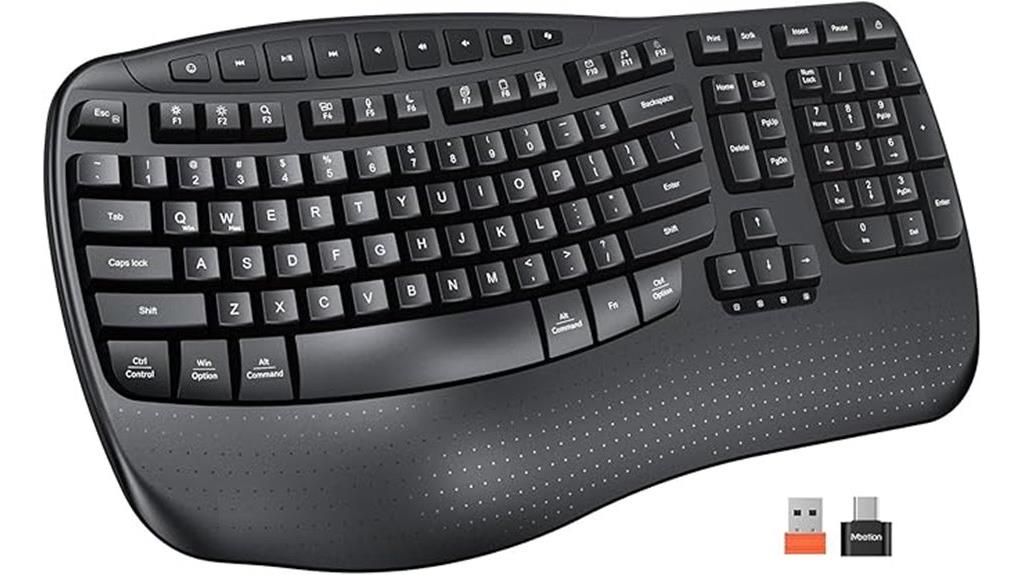
Designed with natural finger movement in mind, the MEETION Wireless Ergonomic Keyboard with Wrist Rest offers a wave key layout and curved surface that promote comfortable, relaxed typing—making it an excellent choice for users with small hands who want a familiar yet supportive ergonomic solution. Its scientifically crafted wave design ensures accurate key reach, while the ergonomic curve guides wrists and fingers to stretch naturally. The wide palm rest and adjustable stand help reduce fatigue during long hours at the keyboard. With reliable 2.4GHz wireless connectivity, compatibility across multiple devices, and easy system switching, it combines comfort, efficiency, and convenience seamlessly.
Best For: users with small hands seeking an ergonomic, comfortable keyboard that offers natural finger movement and reliable wireless connectivity for long hours of typing.
Pros:
- Scientifically designed wave key layout for accurate and natural key reach
- Ergonomic curved surface and wide palm rest reduce wrist fatigue
- Compatible with multiple devices and easy system switching via FN keys
Cons:
- Requires two AAA batteries (not included), which may need frequent replacement
- Some users might find the lack of a split keyboard design less adjustable for extreme ergonomic needs
- Auto sleep mode may cause slight delays when waking the keyboard during short breaks
X9 Wired Ergonomic Keyboard with Cushioned Wrist Rest
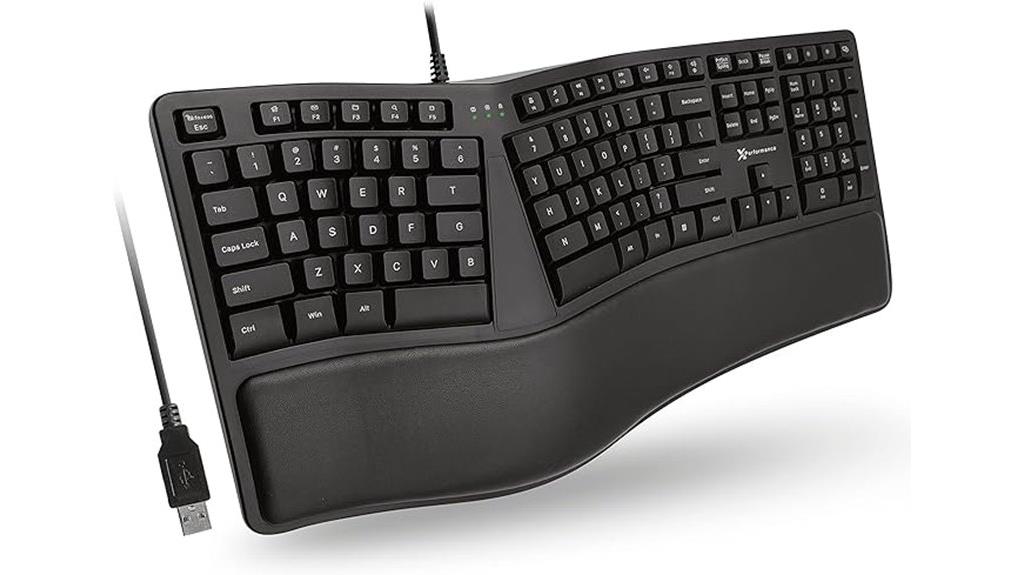
If you have small hands and struggle with standard keyboards, the X9 Wired Ergonomic Keyboard offers a comfortable solution. Its split, wave-shaped design promotes natural hand positioning, reducing strain during long hours. The cushioned wrist rest adds extra comfort, keeping your hands level with the keys for better efficiency. Adjustable kickstands let you tilt the keyboard to your preferred angle, enhancing comfort. With a compact footprint, it frees up desk space. Featuring a full 110-key layout with shortcut keys, numeric keypad, and LED indicators, it’s compatible with PCs and Chrome OS, offering reliable, quiet typing without the need for software.
Best For: users with small hands or those seeking an ergonomic, comfortable keyboard for long hours of typing, office work, or casual use.
Pros:
- Promotes natural hand positioning with split, wave-shaped design to reduce strain.
- Cushioned wrist rest and adjustable tilting enhance comfort during extended use.
- Quiet keys with tactile feedback provide a pleasant typing experience without noise.
Cons:
- Lacks dedicated media keys and backward tilt, which some users prefer.
- Slightly shorter left column keys may take time to adapt to.
- Some users may find the absence of software customization options limiting.
Perixx Periboard-612B Wireless Ergonomic Split Keyboard

For users with small hands seeking an ergonomic keyboard that promotes natural posture, the Perixx Periboard-612B stands out with its split-key layout and integrated palm rest. This design helps support your wrists, reduce median nerve pressure, and minimize forearm tension, making long typing sessions more comfortable. The tactile responsive keys with long travel offer satisfying feedback, reducing mistypes and fatigue. It connects wirelessly via Bluetooth or 2.4GHz, supporting both Windows and Mac systems. Though it lacks backlit keys, its durable build, quiet keys, and full-size layout with multimedia controls make it ideal for those prioritizing comfort and efficiency in a compact form.
Best For: users with small hands seeking an ergonomic keyboard that promotes natural posture and reduces wrist strain during long typing sessions.
Pros:
- Ergonomic split-key layout with integrated palm rest for enhanced comfort and wrist support
- Wireless connectivity via Bluetooth and 2.4GHz with seamless device switching
- Quiet, tactile responsive keys with long travel for satisfying feedback and reduced mistypes
Cons:
- Lacks backlit keys, which may be a drawback for low-light environments
- Slight learning curve due to ergonomic split design and layout adjustments
- Some users report layout quirks, such as key placement differences from traditional keyboards
Kensington Pro Fit Ergonomic Wired Keyboard- Black (K75400US)
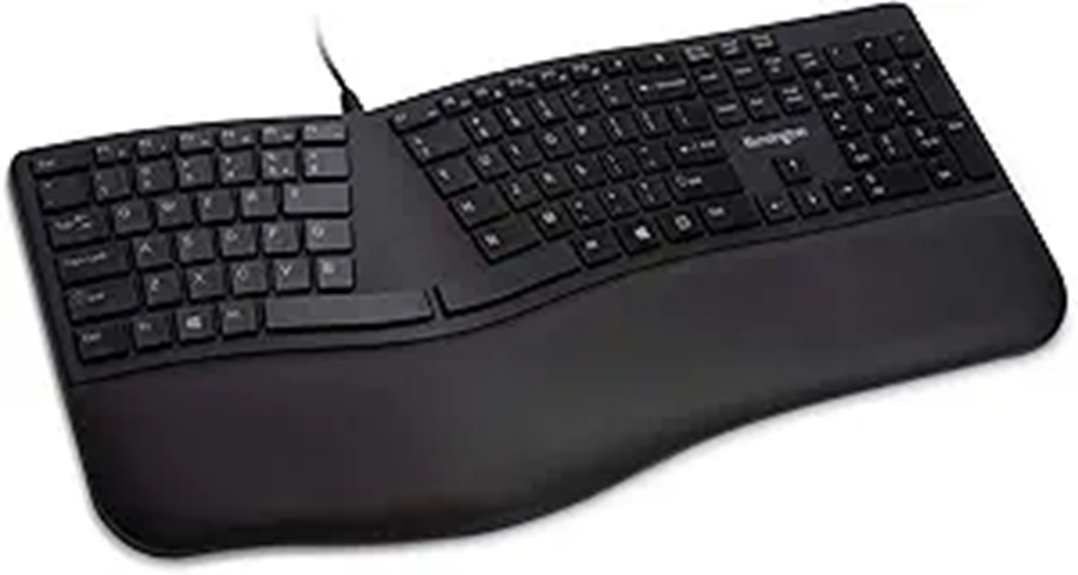
The Kensington Pro Fit Ergonomic Wired Keyboard (K75400US) stands out as an excellent choice for users with small hands who need a comfortable, well-structured keyboard. Its ergonomic design includes a built-in wrist rest, cushions, and neutral grip supports, promoting proper wrist positioning and reducing strain during long typing sessions. The quiet, spill-proof keys ensure smooth, non-disruptive typing and ease of cleanup, while meeting MIL-STD-810H standards for durability. Functional keys like caps lock, scroll lock, and F-keys enhance efficiency. Overall, this keyboard balances comfort, durability, and usability, making it a smart option for small-handed users seeking a reliable, ergonomic workspace.
Best For: users with small hands seeking an ergonomic, comfortable, and durable wired keyboard for extended typing sessions.
Pros:
- Ergonomic design with built-in wrist rest, cushions, and neutral grip supports for enhanced comfort.
- Quiet, spill-proof keys that provide smooth typing and easy cleanup, increasing durability.
- Meets MIL-STD-810H standards, ensuring resistance to cleaning agents and disinfectants for long-term reliability.
Cons:
- Wired connection may limit mobility compared to wireless keyboards.
- May be less customizable or feature-rich than higher-end ergonomic keyboards.
- The compact design might not accommodate users who prefer larger key spacing or additional macro keys.
Ergonomic Wireless Keyboard with Cushioned Wrist Rest

Designed with comfort in mind, the Ergonomic Wireless Keyboard with Cushioned Wrist Rest is an excellent choice for those with small hands seeking a natural typing experience. It features an integrated cushioned palm rest made of leather and high-density support pads, reducing hand pressure and providing wrist support. The wave-shaped ergonomic keys promote a natural hand posture, easing strain during long sessions. Its upright position and large multi-function device holder enhance comfort and multitasking. Wireless and compatible with Windows, Mac, Chromebook, and more, it offers mobility without sacrificing functionality. Overall, it’s a reliable option for users prioritizing ergonomic design and convenience in a compact, versatile keyboard.
Best For: users with small hands seeking an ergonomic, comfortable, and versatile wireless keyboard for long typing sessions.
Pros:
- Ergonomic design with cushioned palm rest and wave-shaped keys reduces hand and wrist strain.
- Compatible with multiple operating systems including Windows, Mac, and Chromebook, with easy system switching.
- Features a large multi-function device holder and silent full-size keys, enhancing multitasking and comfort.
Cons:
- Battery setup may be unclear, and batteries might not fit standard AA sizes, requiring troubleshooting.
- Some users desire additional functions like a calculator button for increased convenience.
- Price and availability can vary, and warranty details may require further clarification.
EDJO Wireless Ergonomic Keyboard with Wrist Rest, 2.4GHz Full Size Cordless USB Keyboard
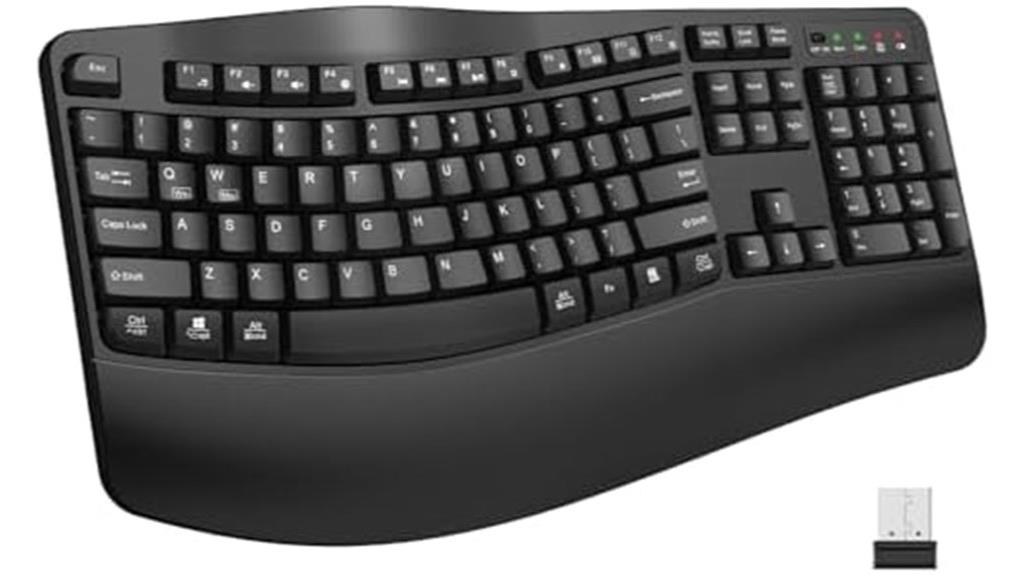
If you have small hands and struggle with traditional keyboards, the EDJO Wireless Ergonomic Keyboard with Wrist Rest offers a thoughtful solution. Its wave-shaped keys and curved layout mimic natural finger movement, reducing strain and boosting accuracy. The wide palm rest supports your wrists, helping maintain a relaxed posture during long typing sessions. Adjustable tilt options add comfort and customization. Compatible with both Mac and Windows devices via a stable 2.4GHz wireless connection, it provides a reliable, plug-and-play experience up to 33 feet away. Lightweight and portable, this keyboard is designed to promote ergonomic comfort without sacrificing responsiveness or functionality.
Best For: users with small hands or those seeking an ergonomic keyboard to reduce strain during long typing sessions.
Pros:
- Wave-shaped keys and curved layout enhance natural finger movement and accuracy.
- Wide palm rest and adjustable tilt options promote comfortable, relaxed posture.
- Compatible with Mac and Windows devices via a stable 2.4GHz wireless connection, with plug-and-play setup.
Cons:
- Requires AA batteries (not included), which may need frequent replacement depending on usage.
- Some users may find the loud key sound distracting.
- Slightly slick wrist rest design could affect comfort for extended use.
Factors to Consider When Choosing Ergonomic Keyboards for Small Hands
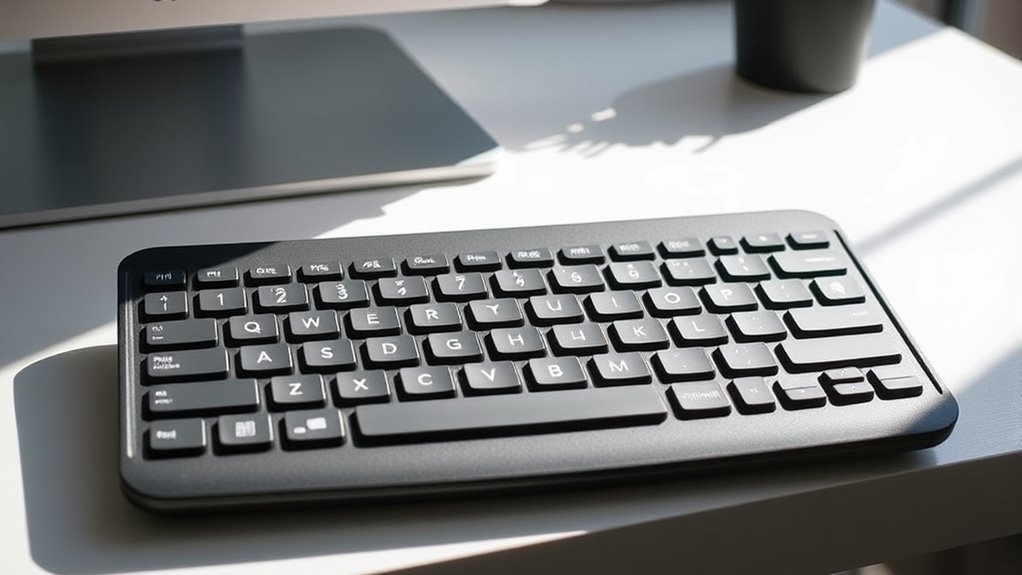
When choosing an ergonomic keyboard for small hands, I focus on key size and spacing to guarantee comfort and accuracy. I also consider the overall width and adjustable tilt features to match my hand and wrist fit. Paying attention to key travel and response helps me find a setup that feels natural and reduces strain.
Key Size and Spacing
Have you ever struggled to comfortably reach and press keys on a standard keyboard? If so, you’ll understand why key size and spacing matter for small hands. Smaller hands need keys with reduced width and shorter travel distances to avoid overstretching and fatigue. Proper spacing between keys is essential; it prevents accidental presses and helps you maintain precise finger placement. Compact layouts with condensed key clusters minimize the reach for frequently used keys, enhancing overall ergonomics. However, spacing shouldn’t be too wide, as excessive gaps can cause discomfort or slow down your typing. Ergonomic keyboards designed for small hands often feature narrower keycaps and optimized placement, reducing strain and improving control. Choosing the right key size and spacing can make a significant difference in comfort and efficiency.
Overall Keyboard Width
Choosing the right overall keyboard width is essential for small-handed users because it directly impacts how comfortably you can reach all the keys without overstretching. Narrower keyboards, around 14 to 15 inches wide, are usually ideal since they match smaller hand spans and reduce strain. On the other hand, overly wide keyboards, over 17 inches, can cause awkward finger stretching and discomfort. Compact layouts that omit or combine keys help decrease the overall width, making it easier to reach every key naturally. Before purchasing, measure your hand span and workspace to ensure the keyboard fits comfortably within your limits. A well-chosen width allows for smoother typing, minimizes fatigue, and enhances overall ergonomic comfort for small hands.
Key Travel and Response
Ever wonder how key travel and response affect your comfort and efficiency on an ergonomic keyboard? Shorter key travel distances can lessen finger fatigue and boost typing speed, especially for small hands. Responsive keys with quick actuation require less force, helping you register keystrokes accurately without strain. Tactile feedback and low latency are essential—they prevent missed or double presses during fast typing. Keys with a gentle, consistent response curve make typing more comfortable and give you better control, which is critical if you have limited finger strength. Additionally, adjusting responsiveness settings or selecting keyboards with mechanical or semi-mechanical switches can fine-tune the feel to suit your needs. Overall, choosing the right key travel and response enhances both comfort and productivity for small-handed users.
Hand and Wrist Fit
A keyboard’s fit for small hands depends largely on how well it aligns with the natural position of your wrists and fingers. An ergonomic keyboard designed for small hands should have a narrower key layout and be less wide, making it easier to reach all keys comfortably. A built-in wrist rest or palm support that matches your hand size helps maintain a neutral wrist position, reducing strain. Key placement and spacing are vital; they should accommodate shorter finger spans to minimize excessive movement and discomfort. Additionally, features like adjustable tilt or tenting allow you to customize the angle, promoting better wrist alignment. A split or compact design can further improve fit by encouraging proper hand positioning and preventing overreaching, ultimately enhancing comfort and efficiency during use.
Adjustable Tilt Features
Adjustable tilt features play a crucial role in customizing an ergonomic keyboard to fit small hands comfortably. By allowing me to adjust the keyboard’s angle, it helps me maintain a natural wrist position and reduces strain during long typing sessions. Multiple tilt options let me find the most comfortable angle, preventing awkward wrist bending and improving overall comfort. This adjustability also accommodates different desk heights and personal ergonomic preferences, making my workspace more adaptable. Proper tilt adjustment can considerably decrease the risk of repetitive strain injuries by helping me keep a neutral hand posture. Many ergonomic keyboards include these adjustable tilt mechanisms, ensuring I can optimize my setup for better alignment, increased comfort, and enhanced typing efficiency.
Layout and Key Placement
When selecting an ergonomic keyboard for small hands, layout and key placement are critical factors that can considerably impact comfort and efficiency. I look for keyboards with a compact design and narrower key spacing to reduce finger stretch and fatigue. The placement of modifier keys like Shift, Ctrl, and Alt should be closer to the home row, minimizing reaching and improving speed. Split or curved layouts help promote natural wrist and finger positions, decreasing strain during long typing sessions. Some models feature vertically or staggered Enter keys and repositioned function keys for easier access. A well-designed layout balances key size, spacing, and placement, ensuring full functionality without sacrificing comfort. These features make a significant difference in reducing discomfort and increasing productivity for small-handed typists.
Connectivity Options
Are you choosing the right connectivity option for your ergonomic keyboard? Your workspace and daily needs influence this decision. Wired USB connections are dependable and offer lag-free performance, but they limit mobility and add clutter. Wireless options like Bluetooth and 2.4GHz dongles boost flexibility, making them perfect for small desks or on-the-go use. Bluetooth allows you to connect multiple devices and switch easily, though some models may have slight latency or pairing hiccups. 2.4GHz wireless provides a stable connection with minimal lag, ideal for seamless typing. Your choice depends on device compatibility, how much space you have, and whether you prioritize wired reliability or wireless convenience. Consider these factors carefully to find the connectivity option that best suits your ergonomic setup.
Build and Material Quality
Choosing the right connectivity option sets the stage for a comfortable ergonomic workspace, but equally important is the build and material quality of the keyboard itself. High-quality ergonomics rely on durable materials like reinforced plastics, aluminum, or metal bracing, ensuring the keyboard withstands daily use. Heavier builds often offer better stability, preventing unwanted shifting during typing. Premium construction keeps key switches, stabilizers, and structural components responsive and resistant to wear, maintaining efficiency over time. Well-made keyboards feature sturdy, slip-resistant bases and quality keycaps that resist chipping, fading, and dirt buildup. The choice of materials also impacts tactile feel and noise levels, both essential for comfort and focus, especially for small-handed users seeking a smooth, quiet, and reliable typing experience.
Frequently Asked Questions
Do Ergonomic Keyboards Improve Typing Speed for Small Hands?
I believe ergonomic keyboards can definitely improve typing speed for small hands. When I switched to one, I noticed less strain and more comfort, which helped me type faster and more accurately. These keyboards are designed to reduce fatigue and improve hand positioning, making them especially beneficial for small hands that might struggle with standard layouts. Overall, investing in an ergonomic keyboard helped me boost my efficiency and enjoy typing more.
Are Split Keyboards Better for Small Hand Ergonomics?
I believe split keyboards can be better for small hands because they reduce wrist strain and allow for a more natural typing position. When I tried one, I felt less discomfort and improved ergonomics. They let me customize the split angle, making typing more comfortable. If you’re struggling with traditional layouts, a split keyboard might be a smart choice to enhance comfort and reduce fatigue.
How Do Wrist Rests Affect Small Hand Comfort?
Wrist rests can markedly boost comfort for small hands by providing support and reducing strain during extended typing sessions. I find that they help keep my wrists in a neutral position, preventing awkward angles that cause fatigue. However, I make sure not to rest my wrists too heavily, as that can lead to discomfort. Properly adjusted wrist rests are a simple yet effective way to improve overall ergonomic comfort.
Can Wireless Keyboards Reduce Hand Strain Effectively?
Wireless keyboards can substantially reduce hand strain, and I swear, they’re like a magic wand for comfort. Without tangled cords, I move more freely, preventing awkward angles that cause pain. Plus, I can position my keyboard exactly where I need it, which is a game-changer for small hands. They’re not just convenient; they’re a powerful tool to keep your hands happy and healthy during long hours of typing.
What Is the Ideal Key Size for Small Hands?
When considering the ideal key size for small hands, I find that keys around 15-16mm in width work best. They’re large enough to type comfortably without overextending my fingers, but not so big that they cause awkward stretches. I recommend trying keyboards with slightly smaller keys, ensuring they’re well-spaced for accuracy. Ultimately, finding a size that fits your hand comfortably boosts both efficiency and comfort during long typing sessions.
Conclusion
Did you know that about 45% of keyboard users experience discomfort or pain? Finding the right ergonomic keyboard for small hands can make a huge difference in comfort and productivity. By choosing a model that suits your grip and typing style, you’ll not only prevent strain but also enjoy a more efficient workflow. Remember, investing in the right keyboard is investing in your long-term health and comfort—so don’t settle for less!
